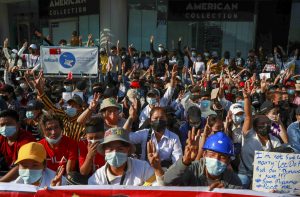Myanmar’s coup can no longer be described as “bloodless.”
During protests in the capital Naypyidaw yesterday afternoon, several people were reportedly shot as police fired live ammunition at protesters massing near the city’s Thapyaygone roundabout.
Among the most severely injured was a young woman named Mya Thwe Thwe Khine, 20, who was shot in the back of the head and reportedly remains in critical condition.
The shooting, which was confirmed by medical staff at a hospital in Naypyidaw, took place as police employed water cannon and fired rubber bullets in order to disperse thousands of people protesting the military’s seizure of power on February 1.
According to a report by the rights group Human Rights Watch, a doctor from the hospital said the woman had a “projectile lodged in her head and had lost significant brain function.”
A short video doing the rounds on social media showed Mya Thwe Thwe Khine falling to the ground after a loud crack, apparently a shot from a line of police deployed nearby. According to Human Rights Watch, there were “no actions by Mya Thwe Thwe Khine in the video that would suggest she was engaged in or threatening violent acts, or had anything in her hands.”
A 20-year-old man is also being treated at a Naypyidaw hospital for a wound that doctors said was consistent with live ammunition. Other reports suggest that there were a host of minor injuries caused by water cannon and rubber bullets.
The shootings carry have an ominous resonance in a country where the military, or Tatmadaw, deployed deadly force to crush nationwide uprisings in 1988 and 2007, in addition to its ruthless attempts to quash ethnic insurgents along the country’s periphery.
Despite imposing a curfew and tightly restricting gatherings in 36 townships, including in Yangon, Mandalay, and Naypyidaw, protests against the February 1 coup have persisted. On February 9, the day after the imposition of the curfew, tens of thousands – possibly hundreds of thousands – emptied into the streets. Some of the largest have been in the army’s bespoke capital Naypyidaw, a dispersed and sparsely populated city purposefully designed to discourage large public gatherings.
In a sign of the profound and nearly universal opposition to military rule, the protests represent Myanmar society in microcosm. In the tense but jubilant gatherings, protesters of all ages are mixing with government workers, students, workers, doctors, lawyers, and Buddhist monks. Videos posted on social media yesterday even showed several instances in which police officers allowed protesters through barricades or came over to the demonstrators’ side. “I want my fellow police officers to abandon their fears and stand by the side of the people,” one officer told the crowd of protesters in Naypyidaw. “They cannot use violence against us.”
The casualty came as media reports continue to flesh out the events that led to the military’s surprise seizure of power at dawn on February 1. According to a detailed report by Poppy McPherson of Reuters, the coup was preceded by a series of meetings between the NLD and military, aimed at resolving mounting tensions surrounding the Tatmadaw’s allegations of fraud at last November’s election, which saw a massive landslide victory for Aung San Suu Kyi and the NLD.
The report, based on interviews with nine sources, including government advisers and others who worked closely with Aung San Suu Kyi, suggests that the NLD-military talks began after an army spokesperson first raised the possibility of a coup on January 26. The talks continued until January 31, before breaking down over the military’s demands that the opening of parliament on February 1 be rescheduled pending a reexamination of the vote under military supervision.
According to the report, Aung San Suu Kyi “seemed resolute” not to give ground after her election victory, while representatives of Sen. Gen. Min Aung Hlaing at one stage rebuked the civilian government side as “rude and insolent.”
It would be surprising if the Tatmadaw did not have a contingency plan for retaking power – indeed its swift actions on February 1 showed considerable evidence of pre-planning – but the report suggests that the coup was driven as much by pique and wounded pride as by careful political calculation.

































